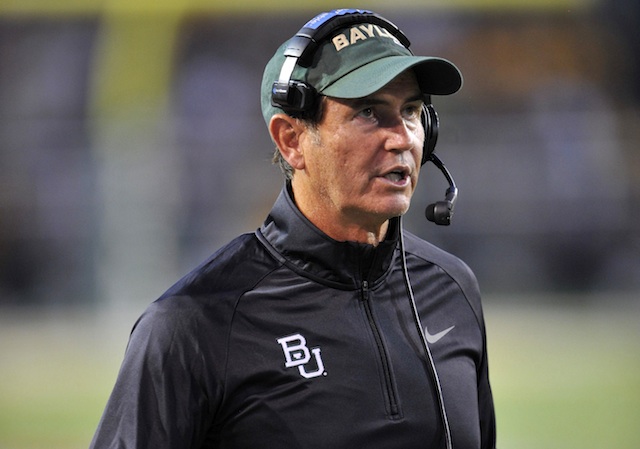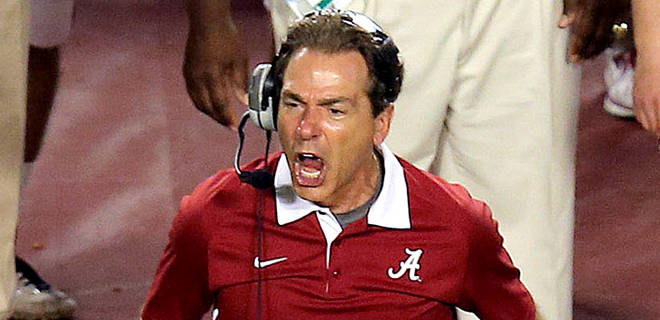See that cover photo? It’s not just a photo of Lou Holtz celebrating Notre Dame’s 1988 national title, the most recent in the program’s storied history. The Fighting Irish conducted their celebration in not just any location — they partied in January of 1989 on a piece of turf known as Sun Devil Stadium. Yes, that’s the same ballyard where Notre Dame will pursue a spot in the College Football Playoff on Saturday afternoon, under clear skies with temperatures in the mid-80s.
Bright sunshine, warm weather, history intersecting with the present moment — that just about sums up the feeling in the college football community about the day that’s in front of us tomorrow. Days like November 8, 2014, remind us why we love the sport. They remind us why, for all the things that might be wrong with the NCAA, the power of college football runs far deeper. It’s true that people can and do fall out of love with sports, especially when the off-field aspects of the sports industry are more visible and off-putting than ever before. However, it remains that almost anyone touched by college football in one’s childhood finds it awfully hard to shake off this sport.
Saturday is a significant day, and it also feels like a celebration — it makes us feel like little kids again, taking us back to a place in the mind and the heart where we can absorb the pure joy of encountering one big late-season game, multiplied six times.
Celebratory and significant. That’s the theme for the day, captured by this piece of NFL Films music at the start of the venerable company’s Super Bowl XIII story:
Days like Saturday — November 8, 2014 — remind us why we watch. They remind us why we care, why we invest ourselves and our emotions in the doings of 19- and 20-year-old male members of the human species.
*
THE SHAPE OF A SPECIAL SATURDAY:
THE CLASH BETWEEN NEW AND OLD MONEY IN COLLEGE FOOTBALL

It’s not a fact or something that can be said with mathematical certainty, but in a few particularly powerful ways, Kansas State-TCU really is the biggest of the six showcase games on Saturday. That’s just one of many reasons why this day is so special, even before any of the games begin.
Six games between top-25 teams on one November Saturday is all college football really needs to say about its big day. Such a reality sells itself. Yet, there’s so much more to mention beneath that surface detail. One of the particularly fascinating aspects of November 8 is the way in which old-money powers and new upstarts coexist in college football. There’s something for almost everyone in this lineup of six duels.
You’ll notice the use of the word “almost.”
What’s the one thing missing from the day? A game of supreme College Football Playoff consequence in which both teams are old-money powers AND have a real shot at the playoff.
The Alabama-LSU game is important to the Crimson Tide in a playoff context, but LSU’s not in the playoff hunt, despite its late-season surge. The game owns playoff relevance for only one of the two traditional SEC stalwarts.
Ohio State-Michigan State might come the closest to meeting this description, but when viewed through the prism of the sport’s fuller history, does Michigan State deserve to be placed on the same plane as Ohio State? Probably not. That’s Michigan’s piece of real estate, even though the Spartans have humiliated and are continuing to humiliate the Wolverines in the present day.
Give Michigan State coach Mark Dantonio this: If he wins on Saturday night and then leads his team back to the Rose Bowl as a College Football Playoff semifinalist, he will wind up producing back-to-back seasons as great as (if not greater than) the other iconic coach from Michigan State’s Big Ten history, Duffy Daugherty (shown in this photo below).
It was Daugherty who led Michigan State to two magical seasons in 1965 and 1966, the zenith of the program in the years before Bo Schembechler moseyed on over to Michigan and began the Ten-Year War with Woody Hayes. Michigan State didn’t lose a single regular-season game in those two seasons. Only the 1966 Rose Bowl — an upset loss at the hands of UCLA — denied Daugherty the right to say that he never lost a game in a two-season stretch. Dantonio and today’s Spartans want to be able to say that they haven’t lost a Big Ten game in a two-season stretch. Their only loss last season came against Notre Dame, and their only loss this season was at the hands of Oregon. Michigan State might not be a traditional power, but the Spartans are definitely becoming one.
*
That last description — not a traditional power, but becoming one — is very much in progress at Baylor, where this wizard has a team that could very well crash the playoff party if it can beat inconsistent old-money foe Oklahoma:
Not a traditional power, but still in the process of becoming one? That process was interrupted when Bill Snyder stepped down from Kansas State, but Snyder hasn’t missed a beat in his second go-round as KSU’s coach. He’s just as sharp, just as masterful, just as excellent as he was in his first stint in Manhattan. Snyder — with wins, not words — continues to make the case that for all we’ve seen from other coaches such as Bob Stoops and Steve Spurrier; from Nick Saban and Urban Meyer; and from Pete Carroll and Bobby Bowden, the best coach of the past 25 years in college football is the man with the snow-white hair.
Not a traditional power, but in the process of becoming one? Texas Christian — more commonly known as TCU in much the same way that people never refer to Louisiana State, only LSU — used to be a traditional power in the 1930s, when Slingin’ Sammy Baugh toted the rock for the Horned Frogs. However, as the Southwest Conference moved through the 1960s, ’70s, and ’80s, TCU faded from prominence. After years of being thrown around like a rag doll in the world of conference realignment, TCU found its young version of Moses. Gary Patterson emerged to take this program to the 2011 Rose Bowl championship and the promised land of the Big 12, the modern-day incarnation of what the old Southwest Conference looked like. The Big 12, being a Texas-centric football league, is TCU’s spiritual home. That the Horned Frogs have so quickly removed doubts about their ability to compete in this power conference has lent powerful new validation to all the work Patterson has done in Fort Worth over an extended period of time. With a win over Kansas State on Saturday night, TCU — with the easiest closing schedule of any playoff contender (including the lack of a conference title game) — will take what could be called the “clubhouse lead” over all the other one-loss teams in the field.
Validation? TCU’s one win away from not necessarily claiming it; the Frogs would set themselves up to claim it as long as they’d avoid a toe-stubbing stumble in the final weeks of the 2014 campaign.
*
Not a traditional power, but in the process of becoming one? That process might not get off the ground on Saturday for Arizona State, but if the Sun Devils can somehow manage to beat the Irish (Vegas doesn’t regard this as an upset, but I would, given the histories of the two programs), they would certainly have a chance play their way into the four-team playoff as the season runs its course. Ever since Frank Kush left the program in the late 1970s, Arizona State has been a place where an excellent coach could win. Weather, facilities, resources — the ingredients for building a colossus have existed in Tempe for some time. Once in a while, good coaches (not great ones) squeezed a Rose Bowl berth out of Los Diablos del Sol, but neither John Cooper nor Bruce Snyder stuck around long enough after their best seasons in the desert. Todd Graham, say what you want about his program-hopping ways, seems invested in making Arizona State a winner. His team is in line to defend its Pac-12 South title from last year. If he can ambush the Irish, Arizona State could set itself up to play in a sexy Pac-12 Championship Game, one that might (we’ll just have to wait and see) serve as a classic play-in game for the playoff.
Yes, if Arizona State finishes the regular season at 11-1, the Sun Devils could meet the team involved in Saturday’s late showdown. The Oregon Ducks weren’t worth anyone’s time or attention before 1994, in a manner akin to Kansas State before Bill Snyder showed up. However, Oregon is certainly a present-day power, and if the Ducks can fend off Utah’s ferocious defense in a Salt Lake City night fight, we could potentially emerge from this special Saturday with the possibility of “11-1 ASU versus 11-1 Oregon” very much intact on the first weekend of December. Don’t forget to watch the second half of Oregon-Utah when the three huge prime-time games have run their course.
*
See that man yelling?
Nick Saban is pursuing a fourth national championship at Alabama. “The Hound” — a nickname I gave Saban in my write-up on the 2013 BCS National Championship Game for College Football News — is chasing The Bear on a larger scale in college football history.
Yet, Saban’s place on this Saturday — November 8, 2014 — is not the headliner of the day. It is certainly ONE headliner — one of six — but not THE headliner. Saban’s place in this day is not what one would refer to as peripheral, but Kansas State-TCU, Notre Dame-Arizona State, and Ohio State-Michigan State are objectively bigger games in this specific respect: Two teams, not just one, have legitimate playoff hopes in those three contests. Alabama-LSU offers potential playoff riches for only one of the two teams on the field.
That last detail — the most powerful and successful coach in college football’s present tense being crowded by the likes of TCU, Arizona State and Michigan State — neatly captures how fascinating this Super Saturday already is, before the games even begin. Old money and new money converge in six supreme showdowns… and the new money has more stakeholders, even though Notre Dame, Alabama, and Ohio State could all carry the banner for Old Money University when the day is done.
*
Saturday, we get to put the Jameis Winston circus behind us.
Saturday, we get to wash out the bitter taste left by the Todd Gurley saga.
Saturday, we get to taste the best of college football, something utterly different from what we’ve seen in the North Carolina academic scandal.
Saturday, we come in contact with six great games, three of them airing consecutively on a night that could crackle with an all-timer of a cresendo at approximately 11 p.m. Eastern time.
It is a cliche, but we are reminded that cliches are cliches because they’re true:
This is why we watch.
This is why we care.
This is why we invest ourselves in the actions of 20-year-olds.
Remember, remember the eighth of November. Pigskin and passion and plot.
I see of no reason why this football season should ever be forgot.




